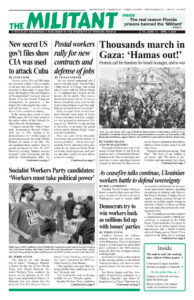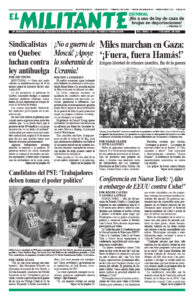President Donald Trump’s efforts to broker a ceasefire three years into Moscow’s invasion of Ukraine is driven by Washington’s need to impose stability to protect and advance its own economic and political interests, including normalizing its relations with Moscow. But Russian President Vladimir Putin’s regime continues pressing forward its assaults on civilian targets, aiming to dismantle Ukraine. Its forces are being met with implacable resistance by working people there.
The Ukrainian government supports a comprehensive ceasefire without preconditions, as proposed by the White House. Putin rejects this. He agreed to a 30-day bar on strikes against energy infrastructure after a March 18 phone call with Trump, and on March 25 to a ceasefire in the Black Sea in exchange for Washington lifting a ban on the export of Russian-made agricultural products. Putin’s agreement is self-serving, as Ukrainian forces have successfully forced the Russian navy out of the Black Sea.
In the days after the Trump-Putin call, Moscow launched daily aerial attacks using 1,100 drones, 1,580 guided bombs and 15 missiles. Three people were killed when Moscow’s forces struck apartments in Kyiv March 23, the first fatalities there in more than two months. A similar number were killed the day before by a drone strike on the port city of Odesa.
Putin’s conditions for an overall truce included ending all foreign military and intelligence aid to Kyiv. Moscow hopes its superior numbers and resources can push back Ukraine’s forces.
Moscow currently occupies 19% of Ukrainian territory. Earlier this month, the Kremlin announced it had finished issuing 3.5 million Russian passports to Ukrainian nationals in the areas it has seized, as it seeks to “Russify” the population. Without passports, Ukrainians living under Moscow’s boot cannot receive health care and pensions, or own property.
Moscow’s advances in Ukraine have largely stalled in recent weeks. Overall battlefield gains for Moscow have been minor over the past year. Over the same period, Russian casualties have doubled, with Putin regarding the lives of Russian workers and farmers in uniform as expendable.
Ukrainian soldier Serhiy told the BBC that Washington and Moscow are “haggling behind Ukraine’s back.” Born in Russia, he chose to fight for Ukraine. He would like the war to end — but not at any price.
The Trump administration is stepping up its demands on Kyiv to make concessions to the U.S. government as part of pushing any peace settlement. Trump wants to expand the deal it made with Kyiv to take over hunks of the country’s rare earth minerals as payment for its aid to Ukraine’s military and to run some of its nuclear power facilities. Trump claims, with some justification, that this would be the “best protection” from further aggression by Moscow.
Ukrainian President Vlodymyr Zelensky said Kyiv was open to U.S. investment in the Zaporizhzhia nuclear plant, the largest in Europe, which was seized by Russian troops at the start of the war. This would require Moscow to cede control back to Ukraine.
Airstrikes hit Russia fuel sites, bases
As Moscow stepped up attacks on civilian targets and urban electrical power generators, Kyiv escalated strikes on Russian military and infrastructure targets. Waves of drones and some missiles hit oil refineries and military targets hundreds of miles deep inside Russia, in the most damaging aerial bombardment there since World War II.
Fuel production and air defense facilities in the Moscow area were hit March 11. In the following few days, air defenses in the Russian-occupied Crimean Peninsula were taken out. A series of oil refineries were hit, as well as rail infrastructure, air bases, power transmission stations and arms production facilities across western Russia.
The ammunition storage at Engels-2 Air Base in Russia’s Saratov region was blown up March 20. It’s one of three bases used by the Kremlin’s heavy bombers to launch missile strikes at Ukrainian cities.
To prevent widespread opposition in Russia to his war exploding, Putin continues to repress opposition. A St. Petersburg military court March 21 sentenced former Soviet dissident Alexander Skobov to 16 years in prison on charges of “terrorism.” His real “crime” is his anti-war views.
Under the Soviet police-state regime in the 1970s and 1980s, Skobov spent six years confined in psychiatric wards. He was an outspoken opponent of the Soviet Union’s invasion of Afghanistan and later Moscow’s wars in Chechnya. He opposed the Putin regime’s seizure of Crimea in 2014 and its invasion of Ukraine in 2022.
In his closing court speech, Skobov accused “Putin’s entire ruling clique” of “preparing, unleashing, and waging a war of aggression, of war crimes in Ukraine, of political terror in Russia.”
After his arrest last year, he issued an open letter to younger political prisoners. “I want the young people who took the hit to know: the last Soviet dissidents stood alongside them,” he wrote.

